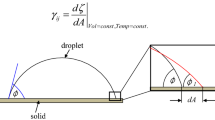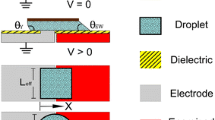Abstract
Electrowetting is one of the most feasible methods for manipulating low-volume droplets on lab-on-a-chip systems. Finding the applied electrowetting force on a droplet and its comparison with movement resistive forces could be very useful in predicting the efficiency of an electrowetting actuator. In this study, the electrowetting force was calculated as a function of droplet position with the aid of analytical way and finite element method (FEM) at different applied voltages. In order to evaluate the results, a coplanar electrowetting actuator with SU-8 dielectric layer was fabricated. Then, an accurate droplet positioning system was utilized and one droplet (10 µl) was positioned on a specific point of the actuator to assess the ability of electrowetting force to overcome the resistive forces. This process was repeated for various points along the workspace of the actuator at different voltages. The experimental results indicated that the errors of FEM and analytical solution in predicting the least moveable voltage was 14%.









Similar content being viewed by others
References
A Winkler, R Brünig, C Faust and R Weser H Schmidt Sens Actuator A Phys. 247 259 (2016)
A A Darhuber, J P Valentino and S M Troian S Wagner J. Microelectromech Syst. 12 873 (2003)
B S Gallardo, V K Gupta, F D Eagerton, L I Jong, V S Craig and R R Shah N L Abbott Science 283 57 (1999)
C Wen, C Yeh and C Tsai L Fu Electrophoresis 30 4179 (2009)
M Shirkosh and Y Hojjat H Sadeghian Flow Meas. Instrum. 48 8 (2016)
X Xu and Y Zhang L Sun Indian J. Phys. 93 427 (2019)
V Srinivasan and V K Pamula R B Fair Anal. Chim. Acta. 507 145 (2004)
X Pei, J Wang and J Zhang X Dai J. Alloys Compd. 905 164273 (2022)
E Naseri and A Van Beek A Physicochem. Eng. Asp. 654 130131 (2022)
M G Pollack, V K Pamula and V Srinivasan Mol. Diagn. 11 393 (2011)
A R Wheeler, H Moon and C Kim R L Garrell Anal. Chem. 76 4833 (2004)
M Khodayari, B Hahne and N B Crane A A Volinsky Appl. Phys. Lett. 102 192907 (2013)
H H Shen and L Y Chung D J Yao Biomicrofluidics 9 22403 (2015)
R Yan and R Pham C Chen Langmuir 36 15571 (2020)
D L Herbertson, C R Evans, N J Shirtcliffe and G McHale Actuators A Phys. 130 189 (2006)
V Srinivasan and V K Pamula R B Fair Lab Chip. 4 310 (2004)
R S Hale V Bahadur Microeng. 27 75004 (2017)
V Bahadur S V Garimella J. Micromech Microeng. 16 1494 (2006)
T B Jones, J D Fowler and Y S Chang C J Kim Langmuir 19 7646 (2003)
Q Ni and D E Capecci N B Crane Microfluid. Nanofluidics. 19 181 (2015)
J Berthier, P Dubois, P Clementz, P Claustre and C Peponnet A Phys. 134 471 (2007)
V Peykov and A Quinn J Ralston Colloid Polym. Sci. 278 789 (2000)
F Mugele J Baret J. Phys. Condens. Matter. 17 705 (2005)
A N Banerjee and S Qian J. Colloid Interface Sci. 362 567 (2011)
H Oprins and B Vandevelde M Baelmans Micromachines 3 150 (2012)
Author information
Authors and Affiliations
Corresponding author
Additional information
Publisher's Note
Springer Nature remains neutral with regard to jurisdictional claims in published maps and institutional affiliations.
This study aims to find the applied electrowetting force on a droplet and compare it with movement-resistive forces which could be very beneficial in predicting the efficiency of an electrowetting actuator. To do so, an accurate droplet positioning system was utilized and one droplet (10 µl) was positioned on a specific point of the actuator to assess the ability of electrowetting force to overcome the resistive forces. Furthermore, the electrowetting force was calculated as a function of droplet position with the aid of analytical way and finite element method (FEM) at different applied voltages. The experimental results indicated that the errors of FEM and analytical solution in predicting the least moveable voltage was 14%. These findings can be adapted as a powerful tool for further developing electrowetting actuators.
Rights and permissions
Springer Nature or its licensor (e.g. a society or other partner) holds exclusive rights to this article under a publishing agreement with the author(s) or other rightsholder(s); author self-archiving of the accepted manuscript version of this article is solely governed by the terms of such publishing agreement and applicable law.
About this article
Cite this article
Ghaffari, A., Hojjat, Y. & Shirkosh, M. A numerical and analytical approach for calculating electrowetting force via droplet positioning method. Indian J Phys (2024). https://doi.org/10.1007/s12648-023-03054-7
Received:
Accepted:
Published:
DOI: https://doi.org/10.1007/s12648-023-03054-7




